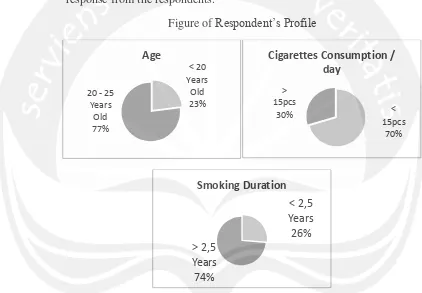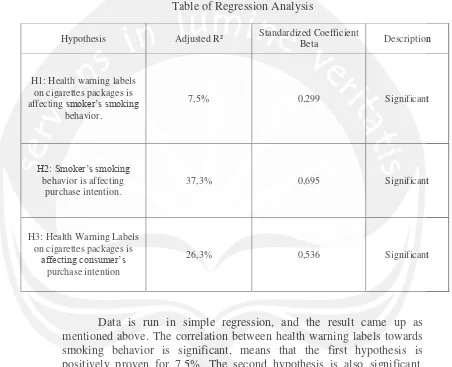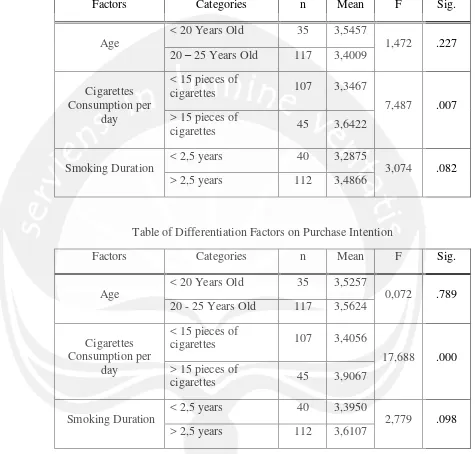THE IMPACT OF HEALTH WARNING LABELS ON CIGARETTES PACKAGED TOWARDS YOUNG SMOKERS
I. INTRODUCTION
1.1. Background
Cigarettes has been existed in Indonesia since long time ago. In facts, the development of cigarettes in Indonesia is getting better since the first time until now. As long as the time goes by, the development of cigarettes packaging is getting more complex and significant.
In 2009, the Indonesian Government enacted a law which regulates the distribution of cigarettes in Indonesia regarding the selling of cigarettes is increasing year per year in order to warn Indonesian citizen about the negative impact of consuming cigarettes. By passing this law, the Governent hopes that Indonesian people will be able to control their health by consuming less cigarettes.
The regulation which warns the Indonesian people about the negative impacts of cigarettes is officially and firmly written. Article 198 of Law number 36 of 2009 on Health determines that the local and international cigarettes companies have to add health warning labels and images on the packaging of cigarettes. Fail to comply to this obligation, the company will be given a maximum of five years imprisonment.
Based on the aforementioned situations, the writer is interested in examining the impact of health warning on packaging of cigarettes towards young smokers.
1.2. Problem Identification
1. Do health warning labels give influence on smoking behavior? 2. Do health warning labels give influence on consumer’s purchase
intention?
1.3. Research Limitation
This research has some limitations in order to keep the research from not going outside the line. First of all, this research is done by focusing only on health warning labels on cigarettes packages for any brands of cigarettes. Secondly, this research is based on the data collection and data analysis which were conducted in October 2015. Thirdly, all of the respondents are in average age range between 18 and 25 years old. Finally, this research is intended primarily to analyze and to see the impact
of health warning labels towards young smoker’s purchase intention.
1.4. Pupose of Study
1. To know whether health warning labels have any influences to smoking behavior or not.
2. To know whether smoking behavior has any influences to purchase intention or not.
1.5. Benefits of Study
The writter – Hopefully, the writter can have a better understanding about the relationship between health warning packages and the purchase intention of young smokers.
The other research – Hopefully, this research can be a good reference for next similar future research.
The reader – Hopefully, the reader can have a better understanding about packaging in marketing and get deeper knowledge about the recent situation and development of cigarettes in this country.
1.6. Research Design
This research is conducted to seek the impact of health warning labels towards smoking behavior and, next, towards purchase intention. The independent variable is health warning labels, while smoking behavior is standing as the intermediate variable. Lastly, purchase intention is there as the dependent variable.
1.7. The Setting
This research is done in Yogyakarta among young smokers in the same average of age range. The data were analyzed by using SPSS 16.00 for Windows.
II. REVIEW OF LITERATURE
2.1. Cigarettes
According to Government Regulation Number 19 of 2003 on the Safekeeping of Cigarettes for Health, a cigarette is processed tobacco wrapped in cylinder shape, including cigars and other forms, consist of Nicotine and similar ingredients completed with or without tar. It is consumed by burning the other edge of the cigarette and smoke it.
2.2. Promotion
of the product to customer, and also good communication requires exact media to be placed where customers are there in the target market circle.
2.3. Packaging
Every company must wrap its product with something, namely packaging. Before we know further more about the packaging itself, it is important to know the theory of attractive quality in packaging (Kano, 1984) which classified packaging into 1) attractive quality; 2) must-be quality: 3) reverse quality; 4) one-dimensional quality; and 5) indifferent quality.
Packaging is specifically related to the strategic decision inside the marketing mix, and further will be used as positioning decisions (Underwood, 2003). Packaging is included as communicative role (Nancarrow, 1998; Underwood and Ozanne, 1998).
Packaging is called “silent salesman” because self-service has transferred the role of incoming the customer from the sales assistant to
advertising and to packaging (Sonsino, 1990). The “silent salesman” will
inform to us of the quality and benefits that we are going to obtain if we consume the product (Vidales Giovannetti, 1995). The ability that packaging has is that it can persuade possible buyers before brand selection (McDaniel and Baker, 1977).
2.4. Health Warning Labels
According to Article 11 of WHO Framework Convention on Tobacco Control (FCTC), a pictorial health warning label means a picture that is applied on cigarette packages in order to increase awareness about the dangers of tobacco use effectively. These are the health warning labels exist in Indonesia.
2.5. Smoking Behavior
Smoking is the act of smoking cigarettes or other similar substance. This action can be repeated in daily life, in every condition. Pierce et al. (1989) stated that smoking behavior for every person is different. It is impossible for two or three or even more persons have the same smoking behavior. The reason is there are differences in smoking prevalence for every different age and racial groups (Tolley et al., 1991; U.S Department of Health and Human Service, 1986; Harris, 1983).
2.6. Purchase Intention
Purchase intention is a very important aspect in marketing literature (Johnson et al, 2006; Oliver, 2009). In order to get a loyal
purchase intention, consumer’s satisfaction is needed (Johnsonet al., 2006; Mazursky and Geva, 1989).
The first previous study is A Consumer Evaluation of Health Warning Labels on Cigarettes Packages in Canada, written by Crane, F.G and MacLean, V.A in 1996. Second previous study is The Potential Effectiveness of Warning Labels on Cigarette Packages: The Perceptions of Young Adult Canadians written by Koval, J.J, Aubut, J.A.L, Linda. L,
O’Hegarty, M and Chan, S (2005).
2.8. Hypothesis
H1: Health warning labels on cigarettes packages can give impact to the smoking behavior of young smokers.
H2: The smoking behavior of young smokers can give impact to consumers purchase intention.
H3: Health warning labels on cigarettes packages can give impact to
consumer’s purchase intention.
III. RESEARCH METHODOLOGY
3.1. Population and Sample Collection Method.
The population in this study is young smokers, mostly college students in the range of age between 18-25 years old. This research is using quantitative approach based on questionnaires distributed to 152 respondents from the total of 170 respondents. This study is using purposive sampling and the questionnaire is given to young smokers. Hopefully, the smokers can evaluate clearly about their purchase intention towards cigarettes which has health warning labels on the package.
The questionnaire contains several questions to be analyzed. Likert Scaling is used to measure all of the answers, which are divided into five categories as follows: (1) Strongly Disagree, (2) Disagree, (3) Neutral (whether agree or disagree), (4) Agree, (5) Strongly Agree. The data were analyzed in simple regression by using SPSS 16.00 for Windows.
IV. CHAPTER 4 - DATA ANALYSIS AND FINDINGS
4.1. Response Rate and Profile of Respondents
[image:5.595.87.509.273.566.2]The result of the response rate is 89,41% which is included as a quite high response rate. It shows that the questionnaire had positive response from the respondents.
Figure of Respondent’s Profile
All the figures above shows us the respondent’s profile. In the questionnaire, respondents are asked about their age, their cigarettes consumtion per day and their smoking duration. As the result regarding the data that has been collected, most of the repondents are in age below 20 years old (the minimum age of the respondent is 18 years old) until 25 years old. Most of them smoke less than 15 cigarettes per day, and most of them have been smoking for more than 2,5 years.
4.2. Validity, Reliability and Regression
Table 4.1.3 below shows the validity and reliability of the variables, and also the correlation among variables which is going to prove the hypothesis.
< 20 Years
Old 23% 20 - 25
Years Old 77%
Age
< 15pcs
70% >
15pcs 30%
Cigarettes Consumption / day
< 2,5 Years 26% > 2,5
Years 74%
VARIABLE CRONBACH’S
ALPHA QUESTION
CORRETED ITEM-TOTAL CORRELATION
DESCRIPTION
Health Warning
Labels
0,796
1 .300 Valid
2 .290 Valid
3 .500 Valid
4 .564 Valid
5 .602 Valid
6 .573 Valid
7 .536 Valid
8 .655 Valid
Smoking
Behavior 0,769
1 .451 Valid
2 .548 Valid
3 .639 Valid
4 .524 Valid
5 .558 Valid
6 .346 Valid
7 -.012 Not Valid
8 .176 Valid
9 .331 Valid
10 .669 Valid
11 .389 Valid
Purchase
Intention 0,744
1 .574 Valid
2 .571 Valid
3 .489 Valid
4 .468 Valid
For the three variables, it is clear that they are reliable because the
[image:7.595.87.539.217.584.2]α is more than 0,6 (according to Sugiyono). It means that all of the variable are reliable. A validity test has also been run in order to measure the validity for each item in the variables. Unfortunately, there is 1 item which is not valid and will not be proccessed in simple regression.
Table of Regression Analysis
Hypothesis Adjusted R² Standardized Coefficient
Beta Description
H1: Health warning labels on cigarettes packages is affecting smoker’s smoking
behavior.
7,5% 0,299 Significant
H2: Smoker’s smoking behavior is affecting
purchase intention.
37,3% 0,695 Significant
H3: Health Warning Labels on cigarettes packages is
affecting consumer’s purchase intention
26,3% 0,536 Significant
Data is run in simple regression, and the result came up as mentioned above. The correlation between health warning labels towards smoking behavior is significant, means that the first hypothesis is positively proven for 7,5%. The second hypothesis is also significant, means that smoking behavior do give impact to purchase intention as much as 37,3%. Finally for the last hypothesis, it is proven that health warning labels give impact towards purchase intention for 26,3%. By looking at the result, all the hypothesis is proven significant.
4.3. One Way – ANOVA
Table of Differentiation Factors on Smoking Behavior
Factors Categories n Mean F Sig.
Age
< 20 Years Old 35 3,5457
1,472 .227 20 – 25 Years Old 117 3,4009
Cigarettes Consumption per
day
< 15 pieces of
cigarettes 107 3,3467
7,487 .007 > 15 pieces of
cigarettes 45 3,6422
Smoking Duration
< 2,5 years 40 3,2875
3,074 .082 > 2,5 years 112 3,4866
Table of Differentiation Factors on Purchase Intention
Factors Categories n Mean F Sig.
Age
< 20 Years Old 35 3,5257
0,072 .789 20 - 25 Years Old 117 3,5624
Cigarettes Consumption per
day
< 15 pieces of
cigarettes 107 3,4056
17,688 .000 > 15 pieces of
cigarettes 45 3,9067
Smoking Duration
< 2,5 years 40 3,3950
2,779 .098 > 2,5 years 112 3,6107
V. CHAPTER 5 - CONCLUSION AND SUGGESTIONS
5.1. Conclusions
In this research model, there are 3 variables that are connected each other. First of all, the health warning label which gives impact to the smoking behavior as the second variable, and the third variable is purchase intention, that is effected by the second variable. According to the data analysis, we found that all of the relations are significant.
Health Warning Labels significantly influence smoking behavior for 7,5%. It is not that big to give influences, because it is even less than 50%. Indonesia has regulated the obligation to add health warning labels on cigarettes packages since 2009, but the Government has applied the health warning label obligation only since 2014.
Smoking behavior affects purchase intention for 37,3%. It is not quite affecting purchase intention. Young smokers can determine what they feel and their continuity to keep smoking or not based on their smoking behavior.
On one side, health warning labels cannot give big percentage to affect smoking behavior of the smoker, while on the other side, smoking behavior quite effective in influencing purchase intention. Government already participated to add health warning labels on cigarettes packages to avoid the health issues caused by smoking. However, it probably needs time to make people realize the real meaning of health warning labels on cigarettes packages and reduce their smoking activity.
All of cigarette brands put these images on their packages, therefore, all of the packages look similar. There might be another factors that are exclude from this research model but can differentiate customer preference towards certain brand such as the flavor of the cigarettes, the price of the cigarettes, etc.
5.2. Managerial Implication
Regarding the different place that is taken to do the research, there is a possibility that the result is different. It can happen because of some factors that is existed in the different place, such as culture, point of view or the environment of the society.
Smoking behavior participated in affecting purchase behavior. The relation is positive and the percentage is quite high, it is probably can give more affect to purchase intention.
5.3. Suggestions
There are some suggestions that were made regarding to this research. These suggestions can be usefull for future research that take similar topics.
Another demographic and profiling can be added to the future research, which is the income of every respondents. Every person must have their notes to their finance, this profiling can also be considered as one of the factor affecting purchase intention.


